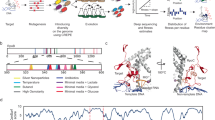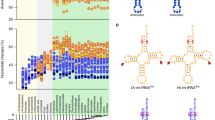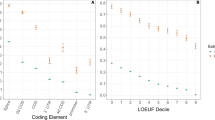Abstract
A long-standing controversy in evolutionary biology is whether or not evolving lineages can cross valleys on the fitness landscape that correspond to low-fitness genotypes, which can eventually enable them to reach isolated fitness peaks1,2,3,4,5,6,7,8,9. Here we study the fitness landscapes traversed by switches between different AU and GC Watson–Crick nucleotide pairs at complementary sites of mitochondrial transfer RNA stem regions in 83 mammalian species. We find that such Watson–Crick switches occur 30–40 times more slowly than pairs of neutral substitutions, and that alleles corresponding to GU and AC non-Watson–Crick intermediate states segregate within human populations at low frequencies, similar to those of non-synonymous alleles. Substitutions leading to a Watson–Crick switch are strongly correlated, especially in mitochondrial tRNAs encoded on the GT-nucleotide-rich strand of the mitochondrial genome. Using these data we estimate that a typical Watson–Crick switch involves crossing a fitness valley of a depth of about 10-3 or even about 10-2, with AC intermediates being slightly more deleterious than GU intermediates. This compensatory evolution must proceed through rare intermediate variants that never reach fixation2. The ubiquitous nature of compensatory evolution in mammalian mitochondrial tRNAs and other molecules10,11 implies that simultaneous fixation of two alleles that are individually deleterious may be a common phenomenon at the molecular level.
This is a preview of subscription content, access via your institution
Access options
Subscribe to this journal
Receive 51 print issues and online access
$199.00 per year
only $3.90 per issue
Buy this article
- Purchase on Springer Link
- Instant access to full article PDF
Prices may be subject to local taxes which are calculated during checkout




Similar content being viewed by others
References
Wright, S. in Proceedings of the Sixth International Congress of Genetics, Ithaca, New York Vol. 1 (ed. Jones, D. F.) 356–366 (Brooklyn Botanic Garden, 1932)
Kimura, M. The role of compensatory neutral mutations in molecular evolution. J. Genet. 64, 7–19 (1985)
Innan, H. & Stephan, W. Selection intensity against deleterious mutations in RNA secondary structures and rate of compensatory nucleotide substitutions. Genetics 159, 389–399 (2001)
Crow, J. F. Mid-century controversies in population genetics. Annu. Rev. Genet. 42, 1–16 (2008)
Wade, M. J. & Goodnight, C. J. Wright’s shifting balance theory: an experimental study. Science 253, 1015–1018 (1991)
Coyne, J. A., Barton, N. H. & Turelli, M. Is Wright’s shifting balance process important in evolution? Evolution 54, 306–317 (2000)
Weinreich, D. M. & Chao, L. Rapid evolutionary escape by large populations from local fitness peaks is likely in nature. Evolution 59, 1175–1182 (2005)
Chen, Y. & Stephan, W. Compensatory evolution of a precursor messenger RNA secondary structure in the Drosophila melanogaster Adh gene. Proc. Natl Acad. Sci. USA 100, 11499–11504 (2003)
Piskol, R. & Stephan, W. Analyzing the evolution of RNA secondary structures in vertebrate introns using Kimura’s model of compensatory fitness interactions. Mol. Biol. Evol. 25, 2483–2492 (2008)
Kondrashov, A. S., Sunyaev, S. & Kondrashov, F. A. Dobzhansky–Muller incompatibilities in protein evolution. Proc. Natl Acad. Sci. USA 99, 14878–14883 (2002)
Kern, A. D. & Kondrashov, F. A. Mechanisms and convergence of compensatory evolution in mammalian mitochondrial tRNAs. Nature Genet. 36, 1207–1212 (2004)
Maynard Smith, J. Natural selection and the concept of protein space. Nature 225, 563–564 (1970)
Poelwijk, F. J., Kiviet, D. J., Weinreich, D. M. & Tans, S. J. Empirical fitness landscapes reveal accessible evolutionary paths. Nature 445, 383–386 (2007)
Dobzhansky, T. Studies on hybrid sterility. II. Localization of sterility factors in Drosophila pseudoobscura hybrids. Genetics 21, 113–135 (1936)
Muller, H. J. Reversibility in evolution considered from the standpoint of genetics. Biol. Rev. Camb. Philos. Soc. 14, 261–280 (1939)
Orr, H. A. The population genetics of speciation: the evolution of hybrid incompatibilities. Genetics 139, 1805–1813 (1995)
Popadin, K. Y., Mamirova, L. A. & Kondrashov, F. A. A manually curated database of tetrapod mitochondrially encoded tRNA sequences and secondary structures. BMC Bioinformatics 8, 441 (2007)
Bazykin, G. A., Kondrashov, F. A., Ogurtsov, A. Y., Sunyaev, S. & Kondrashov, A. S. Positive selection at sites of multiple amino acid replacements since rat-mouse divergence. Nature 429, 558–562 (2004)
Donmez, N., Bazykin, G. A., Brudno, M. & Kondrashov, A. S. Polymorphism due to multiple amino acid substitutions at a codon site within Ciona savignyi . Genetics 181, 685–690 (2009)
Davis, A. R. & Znosko, B. M. Thermodynamic characterization of single mismatches found in naturally occurring RNA. Biochemistry 46, 13425–13436 (2007)
Kelley, S. O., Steinberg, S. V. & Schimmel, P. Functional defects of pathogenic human mitochondrial tRNAs related to structural fragility. Nature Struct. Biol. 7, 862–865 (2000)
Wittenhagen, L. M. & Kelley, S. O. Impact of disease-related mitochondrial mutations on tRNA structure and function. Trends Biochem. Sci. 28, 605–611 (2003)
McFarland, R., Elson, J. L., Taylor, R. W., Howell, N. & Turnbull, D. M. Assigning pathogenicity to mitochondrial tRNA mutations: when ‘definitely maybe’ is not good enough. Trends Genet. 20, 591–596 (2004)
Tanaka, M. & Ozawa, T. Strand asymmetry in human mitochondrial DNA mutations. Genomics 22, 327–335 (1994)
Stewart, J. B. et al. Strong purifying selection in transmission of mammalian mitochondrial DNA. PLoS Biol. 6, e10 (2008)
Sunyaev, S. et al. Prediction of deleterious human alleles. Hum. Mol. Genet. 10, 591–597 (2001)
Howell, N. et al. The pedigree rate of sequence divergence in the human mitochondrial genome: there is a difference between phylogenetic and pedigree rates. Am. J. Hum. Genet. 72, 659–670 (2003)
Malyarchuk, B. A., Rogozin, I. B., Berikov, V. B. & Derenko, M. V. Analysis of phylogenetically reconstructed mutational spectra in human mitochondrial DNA control region. Hum. Genet. 111, 46–53 (2002)
McDonald, J. H. & Kreitman, M. Adaptive protein evolution at the Adh locus in Drosophila . Nature 351, 652–654 (1991)
Popadin, K. Y., Mamirova, L. A. & Kondrashov, F. A. A manually curated database of tetrapod mitochondrially encoded tRNA sequences and secondary structures. BMC Bioinformatics 8, 441 (2007)
Yang, Z. PAML: a program package for phylogenetic analysis by maximum likelihood. Comput. Appl. Biosci. 13, 555–556 (1997)
Kivisild, T. et al. The role of selection in the evolution of human mitochondrial genomes. Genetics 172, 373–387 (2006)
Benson, D. A., Karsch-Mizrachi, I., Lipman, D. J., Ostell, J. & Wheeler, D. L. GenBank. Nucleic Acids Res. 34, D16–D20 (2006)
Edgar, R. C. MUSCLE: multiple sequence alignment with high accuracy and high throughput. Nucleic Acids Res. 32, 1792–1797 (2004)
Ronquist, F. & Huelsenbeck, J. P. MrBayes 3: Bayesian phylogenetic inference under mixed models. Bioinformatics 19, 1572–1574 (2003)
Flynn, J. J., Finarelli, J. A., Zehr, S., Hsu, J. & Nedbal, M. A. Molecular phylogeny of the carnivora (mammalia): assessing the impact of increased sampling on resolving enigmatic relationships. Syst. Biol. 54, 317–337 (2005)
Fulton, T. L. & Strobeck, C. Molecular phylogeny of the Arctoidea (Carnivora): effect of missing data on supertree and supermatrix analyses of multiple gene data sets. Mol. Phylogenet. Evol. 41, 165–181 (2006)
Springer, M. S., Teeling, E. C., Madsen, O., Stanhope, M. J. & de Jong, W. W. Integrated fossil and molecular data reconstruct bat echolocation. Proc. Natl Acad. Sci. USA 98, 6241–6246 (2001)
Teeling, E. C. et al. A molecular phylogeny for bats illuminates biogeography and the fossil record. Science 307, 580–584 (2005)
Price, S. A., Bininda-Emonds, O. R. & Gittleman, J. L. A complete phylogeny of the whales, dolphins and even-toed hoofed mammals (Cetartiodactyla). Biol. Rev. Camb. Philos. Soc. 80, 445–473 (2005)
Agnarsson, I. & May-Collado, L. J. The phylogeny of Cetartiodactyla: the importance of dense taxon sampling, missing data, and the remarkable promise of cytochrome b to provide reliable species-level phylogenies. Mol. Phylogenet. Evol. 48, 964–985 (2008)
Murphy, W. J. et al. Molecular phylogenetics and the origins of placental mammals. Nature 409, 614–618 (2001)
Schmitz, J., Roos, C. & Zischler, H. Primate phylogeny: molecular evidence from retroposons. Cytogenet. Genome Res. 108, 26–37 (2005)
Matsui, A., Rakotondraparany, F., Munechika, I., Hasegawa, M. & Horai, S. Molecular phylogeny and evolution of prosimians based on complete sequences of mitochondrial DNAs. Gene 441, 53–66 (2009)
Horner, D. S. et al. Phylogenetic analyses of complete mitochondrial genome sequences suggest a basal divergence of the enigmatic rodent Anomalurus . BMC Evol. Biol. 7, 16 (2007)
Quérouil, S. et al. Phylogeny and evolution of African shrews (Mammalia: Soricidae) inferred from 16s rRNA sequences. Mol. Phylogenet. Evol. 20, 185–195 (2001)
Douady, C. J. et al. Molecular phylogenetic evidence confirming the Eulipotyphla concept and in support of hedgehogs as the sister group to shrews. Mol. Phylogenet. Evol. 25, 200–209 (2002)
Hatch, L. T., Dopman, E. B. & Harrison, R. G. Phylogenetic relationships among the baleen whales based on maternally and paternally inherited characters. Mol. Phylogenet. Evol. 41, 12–27 (2006)
Xiong, Y., Brandley, M. C., Xu, S., Zhou, K. & Yang, G. Seven new dolphin mitochondrial genomes and a time-calibrated phylogeny of whales. BMC Evol. Biol. 9, 20 (2009)
Acknowledgements
We thank H. Innan, M. Laessig, R. Guigo, I. Povolotskaya, D. Ivankov and M. Breen for thoughtful discussions and critical reading of the manuscript.
Author Contributions M.V.M., Y.A.R. and F.A.K. obtained the initial evolutionary and polymorphism data. A.S.K. and F.A.K. supplied the theoretical treatment of the primary data. F.A.K. designed the study. All authors participated in writing the paper.
Author information
Authors and Affiliations
Corresponding author
Ethics declarations
Competing interests
The authors declare no competing financial interests.
Supplementary information
Supplementary Information
This file contains Supplementary Information, Supplementary Tables 1-4, Supplementary Figure 1 and Supplementary References. (PDF 149 kb)
Rights and permissions
About this article
Cite this article
Meer, M., Kondrashov, A., Artzy-Randrup, Y. et al. Compensatory evolution in mitochondrial tRNAs navigates valleys of low fitness. Nature 464, 279–282 (2010). https://doi.org/10.1038/nature08691
Received:
Accepted:
Published:
Issue Date:
DOI: https://doi.org/10.1038/nature08691
This article is cited by
-
Epistasis-Driven Evolution of the SARS-CoV-2 Secondary Structure
Journal of Molecular Evolution (2022)
-
New Salinity Tolerant Species of Gyrodactylus (Platyhelminthes, Monogenea) on Intertidal and Supratidal Fish Species from the Chilean Coast
Acta Parasitologica (2021)
-
Relaxed sequence constraints favor mutational freedom in idiosyncratic metazoan mitochondrial tRNAs
Nature Communications (2020)
-
Evolution of complex adaptations in molecular systems
Nature Ecology & Evolution (2017)
-
The dynamics of alternative pathways to compensatory substitution
BMC Bioinformatics (2013)
Comments
By submitting a comment you agree to abide by our Terms and Community Guidelines. If you find something abusive or that does not comply with our terms or guidelines please flag it as inappropriate.



